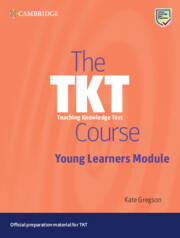Book contents
- Frontmatter
- Acknowledgements
- Contents
- Introduction
- Part 1 Knowledge of young learners and principles of teaching English to young learners
- Part 2 Planning and preparing young learner lessons
- Part 3 Teaching young learners
- Part 4 Assessing young learner learning in the classroom
- Follow-up activities: Answer keys and commentaries
- List of terms found in the TKT Glossary
- Glossary of TKT: Young Learners terms
- Test tips for TKT: Young Learners
- Teaching knowledge test young learners: Practice test
- Sample test answer sheet for TKT: YL practice test
- Answer key for TKT: YL practice test
Unit 5 - Lesson planning: What do I need to think about when planning language lessons for children?
Published online by Cambridge University Press: 14 March 2024
- Frontmatter
- Acknowledgements
- Contents
- Introduction
- Part 1 Knowledge of young learners and principles of teaching English to young learners
- Part 2 Planning and preparing young learner lessons
- Part 3 Teaching young learners
- Part 4 Assessing young learner learning in the classroom
- Follow-up activities: Answer keys and commentaries
- List of terms found in the TKT Glossary
- Glossary of TKT: Young Learners terms
- Test tips for TKT: Young Learners
- Teaching knowledge test young learners: Practice test
- Sample test answer sheet for TKT: YL practice test
- Answer key for TKT: YL practice test
Summary
Introduction to Part 2
Part 2 aims to enrich awareness and skills in planning and preparing lessons for young learners, including analysing, selecting, adapting and supplementing materials and resources for learning.
This part of The TKT Course: Young Learner Module will support your knowledge and skills in preparation for the second part of the TKT: YL Module test: Planning and preparing young learner lessons. You can find more information in the TKT: YL syllabus in the module handbook, which is available online.
In the first unit of this part, Unit 5, we’ll look at lesson planning, thinking about what to take into consideration when planning for young learner lessons. You’ll think about what a lesson plan is, how it might look, and why planning is important, particularly for young learner lessons. Then, you’ll look at what a lesson plan might contain.
Unit 6 turns to classroom materials. You will find out about different types of teaching and learning materials and think about deciding factors when choosing materials. Finally in this unit, you’ll reflect on some issues we may have with materials and how we might change the material to address these issues.
In the next unit, Unit 7, you will find out more about selecting, adapting and supplementing classroom learning resources. This unit will ask you to think about why we use additional resources in young learner classrooms, how we can use them to enrich learning and better meet the needs of our learners. The final section of this unit considers how some additional resources may differ or be used differently with younger and older children in the 6–12 age group.
Towards the end of each unit, you will find follow-up activities, which are designed to deepen and extend your thinking in relation to the unit content. These will help you reflect on the classroom application of your learning in your own context. These are followed by a set of TKT: YL practice questions based on the unit theme. It is recommended that you use your TKT: YL PD Journal to keep and organise your notes.
- Type
- Chapter
- Information
- The TKT Course Young Learners Module , pp. 45 - 53Publisher: Cambridge University PressPrint publication year: 2024



